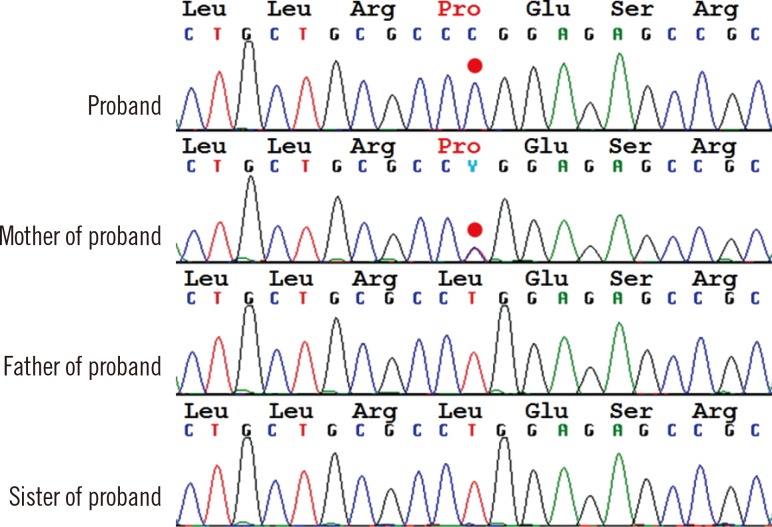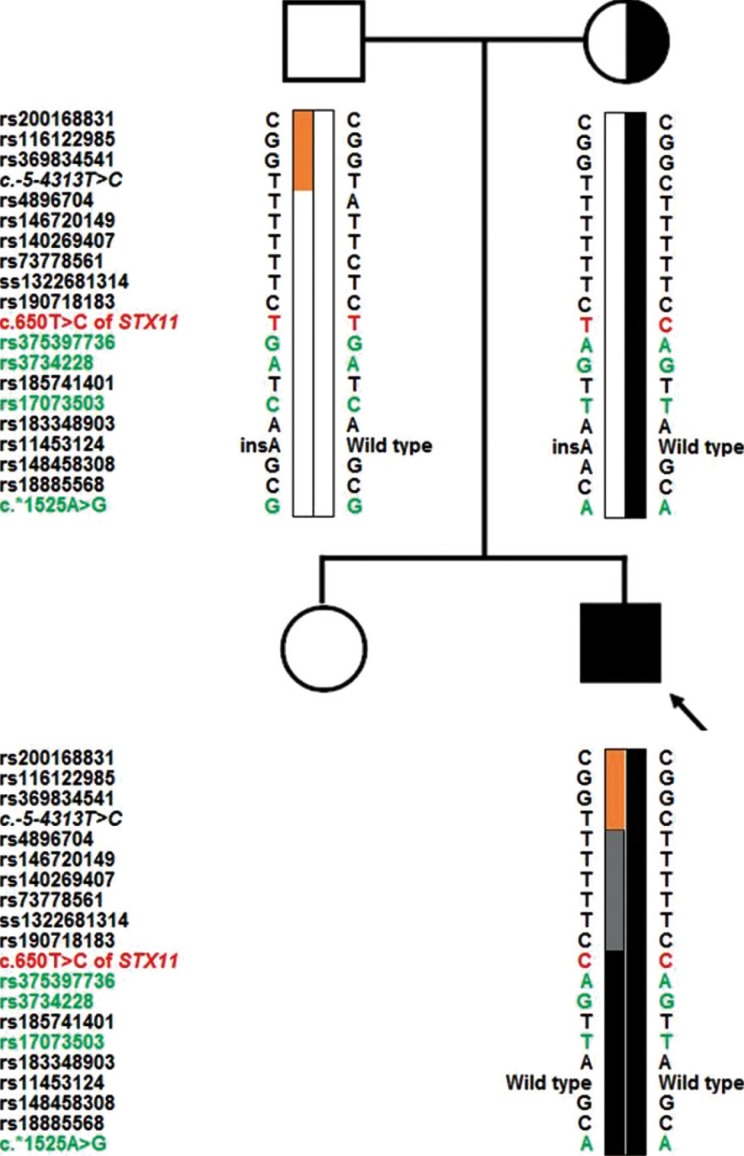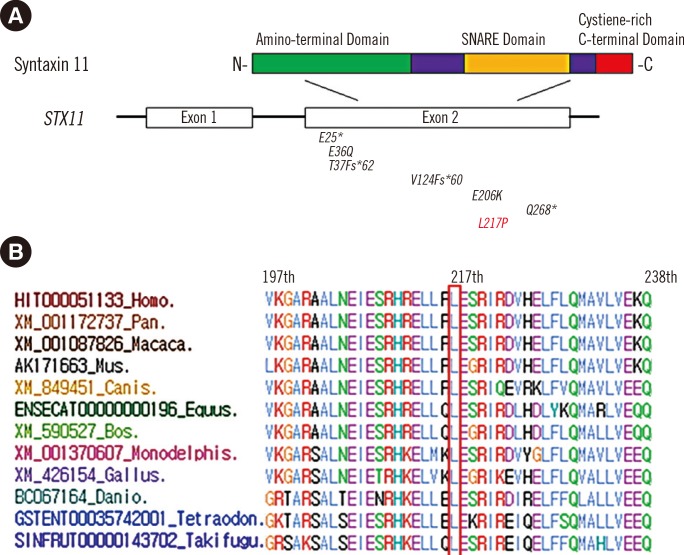Ann Lab Med.
2016 Mar;36(2):170-173. 10.3343/alm.2016.36.2.170.
A Novel Syntaxin 11 Gene (STX11) Mutation c.650T>C, p.Leu217Pro, in a Korean Child With Familial Hemophagocytic Lymphohistiocytosis
- Affiliations
-
- 1Department of Pediatrics, National Research Center for Maternal and Child Health, Astana, Kazakhstan.
- 2Department of Pediatrics, The Catholic University of Korea, Seoul, Korea.
- 3Department of Laboratory Medicine, The Catholic University of Korea, Seoul, Korea. microkim@catholic.ac.kr
- 4Catholic Genetic Laboratory Center, Seoul St. Mary's Hospital, The Catholic University of Korea, Seoul, Korea.
- KMID: 2373518
- DOI: http://doi.org/10.3343/alm.2016.36.2.170
Abstract
- We report the first Far Eastern case of a Korean child with familial hemophagocytic lymphohistiocytosis (HLH) caused by a novel syntaxin 11 (STX11) mutation. A 33-month-old boy born to non-consanguineous Korean parents was admitted for intermittent fever lasting one week, pancytopenia, hepatosplenomegaly, and HLH in the bone marrow. Under the impression of HLH, genetic study revealed a novel homozygous missense mutation of STX11: c.650T>C, p.Leu217Pro. Although no large deletion or allele drop was identified, genotype analysis demonstrated that the homozygous c.650T>C may have resulted from the duplication of a maternal (unimaternal) chromosomal region and concurrent loss of the other paternal allele, likely caused by meiotic errors such as two crossover events. A cumulative study of such novel mutations and their effects on specific protein interactions may deepen the understanding of how abnormal STX1 expression results in deficient cytotoxic function.
MeSH Terms
-
Alleles
Amino Acid Sequence
Asian Continental Ancestry Group/*genetics
Base Sequence
Bone Marrow/metabolism
Child, Preschool
Comparative Genomic Hybridization
DNA Mutational Analysis
Genotype
Haplotypes
Homozygote
Humans
Lymphohistiocytosis, Hemophagocytic/*genetics/pathology
Male
Molecular Sequence Data
Mutation, Missense
Pedigree
Qa-SNARE Proteins/*genetics
Republic of Korea
Sequence Alignment
Qa-SNARE Proteins
Figure
Reference
-
1. zur Stadt U, Schmidt S, Kasper B, Beutel K, Diler AS, Henter JI, et al. Linkage of familial hemophagocytic lymphohistiocytosis (FHL) type-4 to chromosome 6q24 and identification of mutations in syntaxin 11. Hum Mol Genet. 2005; 14:827–834. PMID: 15703195.
Article2. zur Stadt U, Beutel K, Kolberg S, Schneppenheim R, Kabisch H, Janka G, et al. Mutation spectrum in children with primary hemophagocytic lymphohistiocytosis: molecular and functional analyses of PRF1, UNC13D, STX11, and RAB27A. Hum Mutat. 2006; 27:62–68. PMID: 16278825.3. Henter JI, Horne A, Aricó M, Egeler RM, Filipovich AH, Imashuku S, et al. HLH-2004: diagnostic and therapeutic guidelines for hemophagocytic lymphohistiocytosis. Pediatr Blood Cancer. 2007; 48:124–131. PMID: 16937360.
Article4. Horne A, Ramme KG, Rudd E, Zheng C, Wali Y, al-Lamki Z, et al. Characterization of PRF1, STX11 and UNC13D genotype-phenotype correlations in familial hemophagocytic lymphohistiocytosis. Br J Haematol. 2008; 143:75–83. PMID: 18710388.5. Sepulveda FE, Debeurme F, Ménasché G, Kurowska M, Côte M, Pachlopnik Schmid J, et al. Distinct severity of HLH in both human and murine mutants with complete loss of cytotoxic effector PRF1, RAB27A, and STX11. Blood. 2013; 121:595–603. PMID: 23160464.
Article6. Yoon HS, Kim HJ, Yoo KH, Sung KW, Koo HH, Kang HJ, et al. UNC13D is the predominant causative gene with recurrent splicing mutations in Korean patients with familial hemophagocytic lymphohistiocytosis. Haematologica. 2010; 95:622–626. PMID: 20015888.
Article7. Yamamoto K, Ishii E, Horiuchi H, Ueda I, Ohga S, Nishi M, et al. Mutations of syntaxin 11 and SNAP23 genes as causes of familial hemophagocytic lymphohistiocytosis were not found in Japanese people. J Hum Genet. 2005; 50:600–603. PMID: 16180048.
Article8. Zhizhuo H, Junmei X, Yuelin S, Qiang Q, Chunyan L, Zhengde X, et al. Screening the PRF1, UNC13D, STX11, SH2D1A, XIAP, and ITK gene mutations in Chinese children with Epstein-Barr virus-associated hemophagocytic lymphohistiocytosis. Pediatr Blood Cancer. 2012; 58:410–414. PMID: 21674762.
Article9. Marsh RA, Satake N, Biroschak J, Jacobs T, Johnson J, Jordan MB, et al. STX11 mutations and clinical phenotypes of familial hemophagocytic lymphohistiocytosis in North America. Pediatr Blood Cancer. 2010; 55:134–140. PMID: 20486178.
- Full Text Links
- Actions
-
Cited
- CITED
-
- Close
- Share
- Similar articles
-
- A Case of Hemophagocytic Lymphohistiocytosis Presenting with Neck Mass in a Child
- Genetic and clinical characteristics of pediatric patients with familial hemophagocytic lymphohistiocytosis
- Multiple Ecthyma Gangrenosum in a Hemophagocytic Lymphohistiocytosis Patient
- EBV-elicited familial hemophagocytic lymphohistiocytosis
- Novel Mutations in the UNC13D Gene Carried by a Chinese Neonate with Hemophagocytic Lymphohistiocytosis




